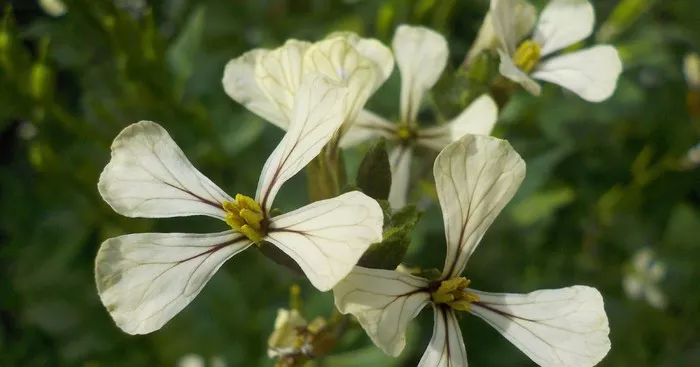Rocket flowers, also known as arugula flowers, belong to the Brassicaceae family and are renowned for their delicate yet captivating appearance. While their edible leaves are widely recognized for their peppery flavor and culinary uses, the flowers of this plant are equally intriguing. In this article, we delve into the anatomy, variations, significance, and cultivating practices of rocket flowers, uncovering the secrets behind their allure.
Anatomy of Rocket Flowers
Rocket flowers emerge from the arugula plant, scientifically known as Eruca sativa. These blossoms typically feature four petals arranged in a cross-like shape, characteristic of plants within the Brassicaceae family. The petals may range in color from pale white to creamy yellow, sometimes adorned with delicate veins or spots.
At the center of the flower, a prominent pistil rises, surrounded by stamens tipped with pollen-laden anthers. This reproductive structure facilitates the pollination process, essential for the plant’s reproduction. The flowers are borne on slender stalks, which extend from the leafy rosettes of the arugula plant.
While the flowers are small in size compared to some ornamental blooms, their elegance lies in their simplicity and understated beauty. They exude a subtle fragrance, often reminiscent of the plant’s distinctive peppery aroma.
Variations in Rocket Flowers
Rocket flowers exhibit variations in color and form, influenced by factors such as cultivar, environmental conditions, and stage of development. While the most common hues are white and yellow, some cultivars may produce flowers with hints of lavender or purple, adding a splash of color to the garden.
The shape of the petals can also vary slightly, with some flowers sporting rounded edges while others exhibit more pointed or serrated outlines. Additionally, the size of the flowers may differ depending on the plant’s age and health, with some individuals producing larger blooms than others.
In terms of growth habit, arugula plants can be classified into two main types: wild rocket (Diplotaxis tenuifolia) and cultivated rocket (Eruca sativa). Wild rocket tends to have smaller, more deeply lobed leaves and a more pungent flavor compared to its cultivated counterpart. The flowers of wild rocket may also exhibit slight differences in appearance, with variations in petal shape and color intensity.
Significance of Rocket Flowers
While rocket flowers may not be as widely celebrated as other ornamental blooms, they hold significance in various contexts, ranging from culinary to ecological applications.
In the culinary world, rocket flowers are prized for their subtle peppery flavor, which complements the taste of the plant’s leaves. These delicate blooms can be used to garnish salads, soups, and other dishes, adding a touch of visual appeal and a hint of floral notes to culinary creations. Additionally, the flowers can be infused into vinegar or used to flavor oils, imparting their unique essence to condiments and dressings.
Beyond their culinary uses, rocket flowers play a vital role in supporting pollinators and beneficial insects in the garden. Bees, butterflies, and other pollinators are attracted to the nectar and pollen-rich blooms, which provide a valuable food source during the flowering season. By cultivating arugula plants and allowing them to flower, gardeners can contribute to the conservation of pollinator populations and promote biodiversity in their local ecosystems.
Cultivating Rocket Flowers
Cultivating rocket flowers is a rewarding endeavor that requires minimal effort and resources. Whether grown in garden beds, containers, or window boxes, arugula plants thrive in well-drained soil and full sun to partial shade. Here are some tips for successfully growing rocket flowers:
1. Soil Preparation: Prepare the planting area by loosening the soil and incorporating organic matter such as compost or aged manure to improve fertility and drainage.
2. Sowing Seeds: Rocket seeds can be sown directly into the garden bed or container in early spring or late summer, depending on the climate. Scatter the seeds thinly and cover them lightly with soil, then water gently to ensure good seed-to-soil contact.
3. Watering: Keep the soil consistently moist but not waterlogged, especially during hot weather. Water the plants deeply to encourage robust root growth and prevent wilting.
4. Thinning Seedlings: Once the seedlings emerge, thin them to a spacing of 6-8 inches apart to allow room for the plants to mature and produce flowers without overcrowding.
5. Fertilization: Arugula plants are not heavy feeders but will benefit from a balanced fertilizer applied at half-strength every 4-6 weeks during the growing season.
6. Harvesting Flowers: As the plants mature, they will produce flower stalks topped with buds that will eventually open into blossoms. Harvest the flowers as soon as they open to encourage continued blooming and prevent the plant from setting seed prematurely.
By following these guidelines, gardeners can enjoy a bountiful harvest of rocket flowers and reap the rewards of their efforts throughout the growing season.
Conclusion
Rocket flowers may be small in size, but their beauty and significance extend far beyond their delicate petals. From their graceful form and subtle fragrance to their culinary versatility and ecological importance, these blooms captivate the senses and enrich the garden landscape. By understanding the anatomy, variations, significance, and cultivating practices of rocket flowers, gardeners can cultivate a deeper appreciation for these enigmatic blossoms and harness their potential to enhance both culinary delights and biodiversity in the garden.


